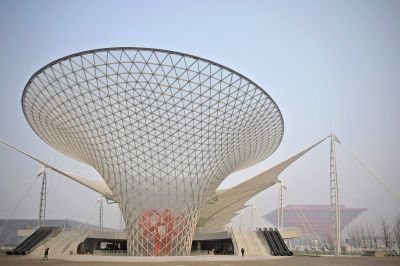China strives for first 'green' Expo

China, the world's number one emitter of greenhouse gases, aims to hold the first "green" World Expo in Shanghai, as the sprawling metropolis tries to shed its polluted past and become eco-friendly.
With less than three months to go before Expo opens on May 1, an army of workers is hurrying to turn what was once China's oldest shipyard into an environmentally friendly oasis in the heart of the country's biggest city.
Solar power, recycled rainwater, hybrid engine buses - organisers and countries participating in the six-month event, expected to draw up to 100 million visitors, are sparing no effort to create a "Better City, Better Life."
"Green thinking, protecting the environment, harmony, low carbon - these are ideas that not only will we display at Expo, but we need to make each visitor feel them," said Shanghai Mayor Han Zheng.
It will be China's largest solar generation project, said Xu Bo, assistant commissioner general for Expo.
Carbon dioxide emissions will be significantly reduced as a result of the measures taken, said Xu.
Several Expo pavilions have been designed to harness the sun's rays.
Solar panels cover the roof of China's national pavilion, "The Oriental Crown," a 60-metre-tall red upside-down pyramid - one of a handful of buildings that will remain at the 5.3-square-kilometre (two-square-mile) site.
The separate urbanisation theme pavilion - big enough to house four passenger planes - is covered in solar panels, and all the lighting used to illuminate the building at night is energy-efficient.
Organisers say the two buildings alone will reduce carbon dioxide emissions by 2,500 tonnes by generating the equivalent in electricity of burning 1,000 tonnes of coal - still Shanghai's main source of power.
The exterior of Japan's pavilion, which officials compare to a giant purple silkworm cocoon, is an intricate layer of flexible solar cells designed to generate between 20 and 30 kilowatts per hour.
The facade of the Swiss Pavilion also experiments with solar batteries that emit flashes once fully charged. The Swiss building also takes rooftop gardens to a new level with a rooftop meadow.
As a sign of the official willingness to make the environment a priority, authorities have warned that factories in the Yangtze River Delta up to 300 kilometres (186 miles) away could be shuttered if on-site air quality is sub-par.
"We'll monitor air quality each day and if it's negative, we'll take emergency measures, including production control or even shutting down certain heavy-polluting companies," said Zhang Quan, head of Shanghai's environmental protection bureau.
Perhaps the most eye-catching eco feature at the Expo site is "Sun Valley" - visitors are greeted at the main entrance by six 40-metre-tall steel and plastic funnels.
The transparent vase-like structures channel the sunlight and breeze underground to provide natural light and cooling.
They also collect rainwater that will be used to flush toilets and run sprinklers for the vast green spaces that cover a third of the venue.
Beneath "Sun Valley," an underground network of 700 kilometres of pipes will use thermal energy from the earth and river water to provide natural heating and cooling for the site, organisers said.
For transportation, visitors will be ferried around in buses with hybrid engines, and a Chinese electric bicycle manufacturer has donated 100 electric cars and 300 electric bikes for Expo staff.
Shanghai's green initiatives do not stop at the Expo gates - the city is striving to become a model for sustainable development in China with flagship projects such as an offshore wind farm built southwest of the city.
In an assessment of the Expo's possible impact, the United Nations Environment Programme (UNEP) said an event of this scale would inevitably lead to a massive increase in carbon emissions unless serious measures were taken.
Lo Sze Ping, who wrote the report, said the air quality in the city has already improved and investments such as expanding metro and train services to a total of 400 kilometres of lines will leave a lasting green legacy.
"What is interesting to see is how the Expo has helped improve the environment in the city over the past 10 years, and what it will do for the next 10 years," Lo said.
Join our commenting forum
Join thought-provoking conversations, follow other Independent readers and see their replies
Comments